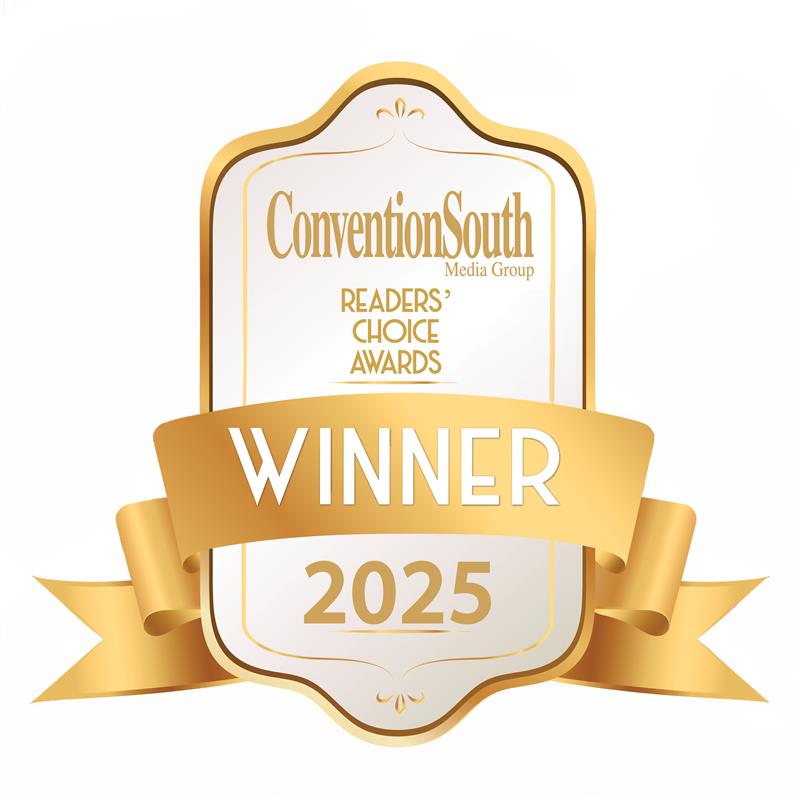
Planners are seeking creative solutions to overcome budget cuts and travel restrictions threatening conference attendance
Geopolitical challenges and economic uncertainty have added urgency to meeting planners’ concerns over having to do more with less, results from ConventionSouth’s 2025 Industry Trends Survey show. Fortunately, there is no price on ingenuity. Planners and their supplier partners are seeking creative solutions to ensure the shows go on.
The South, in particular, remains a desired destination for corporations and associations to gather. The mix of grand hotels, top-tier convention centers, historic venues, and budget-friendly accommodations provides a large array of opportunities for conferences, meetings, and special events.
Planners responding to our annual industry trends survey are on track to host an average of four events in Southern destinations in the next 12 months—and 16.7% are planning 11 or more events.
Conferences (49.6%) and networking events (44.4%) are the most common event types in the study.
“Our future years are either on pace with or slightly ahead of previous trends,” says Joe Bocherer, COO of Georgia World Congress Center in Atlanta. “Looking specifically at 2026, we’re already tracking slightly ahead of 2025.”
As always, our industry survey was administered through a third-party platform to ensure anonymity of respondents. We asked our audience of approximately 18,000 destination and planning professionals to share their responses to a wide range of industry topics, including the number and types of events being planned, attendance, budgets and costs, factors in selecting destinations and venues, technology, and other key areas.
In this article, we analyze the study’s results to shed light on the event industry’s biggest challenges, opportunities for meeting planners to shine, and how national trends are shaping decisions and the event experience.
Current challenges
It’s not unusual for planners to wish for larger budgets and increased staff support, but circumstances in 2025 are distinct from the norm. Tariffs have slowed the supply chain; while the actual effects of the tariffs remain unknown, the fear that they will drive up prices is already having an impact. Survey respondents pointed to four budget pain points among their top challenges heading into next year: higher event costs (84.1%); higher accommodation costs (48.7%); reduced client budgets (46%); and higher transportation costs (34.5%).
Event costs can include increased F&B prices, audiovisual technology, and meeting room and trade show floor set-up, among other line items.
“Everything costs more, and I don’t see it ever going back to costing less,” says Brian Ferrell, CMP, founder and CEO of factor110, an event and destination management company based in Oklahoma City.
While 72.2% of surveyed event professionals report stable or higher attendance in 2025 compared to 2024, the industry may not be as fortunate next year. Of note, 61.2% of respondents report reduced client travel and event budgets.
Reduced attendance can have a ripple effect throughout an organization and its portfolio of events.
A drop in attendees could lead to a perception among exhibitors that an event is not essential to set up a booth. Even if they do participate, there may be a fear of a diminished ROI, which could mean they send fewer staff to the conference. Adding to the financial pressures, reduced attendance can trigger attrition penalties at hotels if too many allotted rooms sit empty.
The danger is greater for associations, which rely on annual conventions to generate revenue and encourage new and renewed membership.
A trend global organizations will surely monitor is the drop of international travel to the United States. According to The World Travel & Tourism Council, the United States is on track to lose $12.5 billion in international visitor spending in 2025.
Major markets may also be fighting a potential “perception” issue should federal troops continue to be called into large cities, as has occurred in Los Angeles and Washington, D.C. To that point, 79.2% of respondents say they are concerned about physical security. Recent high-profile shootings at the NFL headquarters in New York City, the Centers for Disease Control and Prevention in Atlanta, and Utah Valley University could add to those concerns.
Controlling the message
CVBs can proactively address current challenges as a way to encourage associations and corporations to continue to meet.
Melissa Riley, senior vice president of convention sales and services for Destination DC, walks to work in the nation’s capital. She views her hometown as a place that cultivates thought leadership and innovation—its sustainability measures are among the most thorough in the world. Yet at Destination DC’s 2026 marketing outlook meeting, it was announced that 41 groups had decided against holding their conferences in Washington next year, according to The Washington Post. The meetings were worth $54.4 million in economic impact for the city, The Post added.
“Recently, things are changing hour by hour,” notes Riley of the challenges in the capital. “We’re really leaning into social media because of the power to impact that quickly.”
The CVB has effectively launched a new series, “Love Letter to DC,” featuring city residents sharing their positive experiences in the city.
While Washington’s circumstances are unique, there are universal lessons for the events industry, such as leaning into communities to find strength. Just as in Washington, the Atlanta CVB is working its venues like Georgia World Congress Center on marketing and messaging, Bocherer says. He encourages planners to use a similar playbook as Destination DC to convince budget-conscious attendees and vendors to lock in registrations.
“It’s critical for planners to position their events as indispensable rather than optional,” Bocherer says. “It comes down to reputation and strong marketing. Content
is everything when it comes to creating a ‘must-attend’ experience.”
Finding the right venue can help planners convincingly tell that story, adds Kevin Hellmich, director of sales at the Grand Hotel Golf Resort & Spa, Autograph Collection, in Point Clear, Ala. Word is spreading about the historic hotel’s remarkable campus and onsite amenities, which are attracting national groups from the Midwest, Mid-Atlantic, and Northeast. The hotel has been a regional attraction throughout its 178-year history, Hellmich says.
Hosting a championship croquet tournament added positive publicity and highlighted the varied activities attendees can enjoy on site, Hellmich notes. “Attendees want something different. They want something special,” he says.
To help find those one-of-a-kind event homes, 68.5% of survey respondents say they use virtual tours for venue selection, with 55.1% noting they use online tours most of the time.
Another trend gaining popularity is paying for a third-party RFP service, which 40.6% of survey respondents say they pay for. Another 16.7% of planners who don’t use a third-party RFP service indicated they are interested in sourcing one.
Technology is also assisting on the marketing front. With planning staff stretched thin and working long hours on event logistics, organizations are increasingly viewing artificial intelligence (AI) to help with messaging. In fact, 63% of event professionals say they use AI. The most common use is to draft copy (79.3%), followed by conducting research (46.6%), general marketing tasks (39.7%), and creating graphics (34.5%).
Smart savings
Some of the recent challenges are out of planners’ control. As Ferrell explains, some research-based or grant-funded programs have been cancelled days prior to the scheduled start of the show due to budget cuts.
Last-minute loss of funding has dramatically cut down on attendance of other events. “One of our annual programs that typically draws 1,000 attendees will be fortunate to have 250 this year,” Ferrell says.
Because of the last-minute nature of the changes, planners can be helpless to adjust accordingly. The event Ferrell referenced remained under the same contractual obligations—including expenses, minimums, and similar requirements—as if there was the usual complement of attendees.
With enough time to prepare, there are steps planners can take to counter increased rates without sacrificing on the quality of the event.
Top cost-savings measures among the survey respondents are: raising registration prices (41%); holding more small/regional events (38%); scaling back F&B (35%); holding events closer to attendees (29%); and using smaller/drive-in destinations (27%).
Ferrell cites elaborate décor builds, luxury transportation upgrades, and high-end specialty food stations as among the first victims of tighter budgets.
Bocherer adds that he’s seen some groups “piggybacking” on existing stage sets, coordinating decorations from one program to the next so events can share expenses rather than each building from scratch.
Similarly, Ferrell says some groups are partnering with other organizations to “co-locate” or even merge events, sharing resources like venues, speakers, and production costs.
Going local and sustainable
In the events world, priorities are often not mutually exclusive. For instance, as noted above, there is a movement toward regional events, which cuts down on travel costs and eases logistics for planners.
Staying close to home is also a key ingredient of adding sustainability to a conference. According to the International Energy Agency, aviation accounted for 2.5% of global energy-related Carbon Dioxide emissions as of 2023, and the environmental impact grew faster between 2000 and 2019 than rail, road, or shipping.
Regional events are conducive to carpooling, buses, and train travel. Planners also tend to highlight the meeting’s destination, partnering with local vendors for gifts and nonprofit organizations for corporate social responsibility (CSR) activities.
These measures are hallmarks of today’s sustainability playbooks. The ConventionSouth survey found that 45.2% of planners say choosing local and/or sustainable purveyors is important or very important for their events.
Relatedly, nearly half of the survey respondents (49.5%) say they consider environmental impact important in their planning. The most popular measures, according to the report, are: recycling/reuse (53.8%); local sourcing (48.4%); food donation (45.1%); public transit access (35.2%); and water conservation (31.9%).
“Thirty percent of the RFPs we receive require some level of sustainability,” Riley says. “It has shifted from a ‘nice-to-have’ to being a ‘must-have.’”
Another benefit of a regional event, Riley notes, is planners can source from local thought leaders to speak on topics relevant to the organization. Individuals can include civic leaders, organization executives, and academics, among other notable residents. The practice is already common, as 89 of planners who participated in the study say they incorporate local community and culture into their events.
Health and wellness, often connected with sustainability, remains an important factor among 26.4% of the planners surveyed. The most common components are exercise or stretch breaks, yoga, meditation classes, sound baths, and quiet rooms. Another 20.9% of planners who don’t already incorporate wellness into their events plan to do so, according to the survey.
A united events industry
If there is a silver lining to supply-chain and other current challenges facing the industry, it is that they are bringing members together.
Examples range from Destination DC conferring with Discover Los Angeles about responding to National Guard presence in those cities to hotels and venues working with planners on long-term contracts to defer attrition and other potential penalties.
Bocherer says one of the lessons from the COVID pandemic remains relevant in today’s discussions about budget cuts and travel restrictions. “The consistent takeaway from our conversations with clients and exhibitors is clear: They need to be here,” Bocherer says. “The cost-savings of sending fewer people simply doesn’t outweigh the value of being in front of their most important customers.”
Ferrell says his perennial optimism for events has not been deterred. “We’ve survived incredibly difficult, even devastating times, and each challenge has made us stronger, smarter, and more collaborative,” he says. “The uncertainty we face now is real, but it’s also an opportunity to reimagine processes, streamline operations, and rethink marketing. It’s okay to feel overwhelmed, but know you’re not alone. Lean on your partners, suppliers, and peers—our industry thrives on collaboration, and together, we’ll continue to adapt and grow.”
















